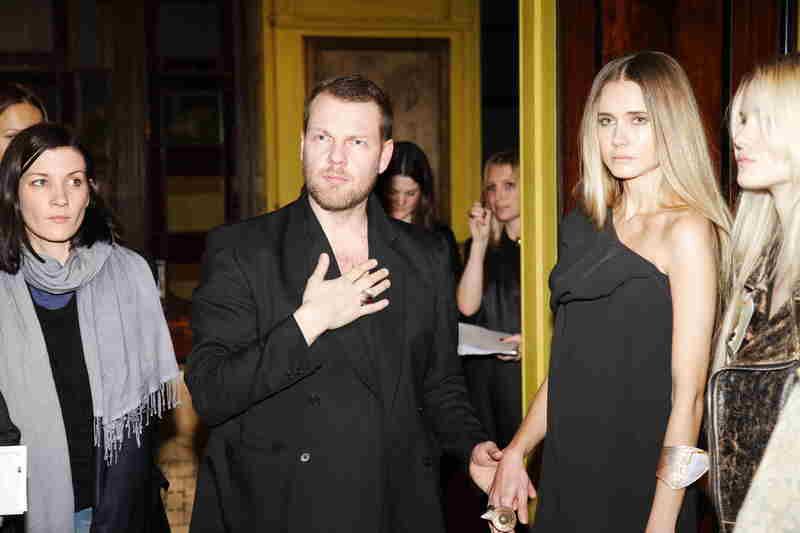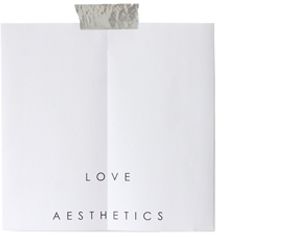
Got a spare five minutes? Paige Powell from interview magazine can take you with her in a lovely conversation with Acne's creative director Jonny Johansson. Personally I love the last part where he talks about the energy that is left over from a collection that is poured into the Acne magazine. But that probably has to do with my obsessive addiction to magazines.
Johansson and three colleagues started the creative collective-and future lifestyle label-in Stockholm in 1996 with the dream of dipping their hands into every possible pocket of art and culture (the name is an acronym for Ambition to Create Novel Expressions). After they unleashed 100 pairs of unisex jeans on friends, family, and clients one year later, the ACNE denim rush was on.
November 28, 2008
Interview Magazine
By Paige Powell
Image Matches fashion
PAIGE POWELL: You've really become something of an impresario, with your film company, jeans, men's and women's lines, even children's toys. Now I hear you will be doing furniture.
JONNY JOHANSSON: We are. For me it was about experimenting, about seeing if there was anything in furniture design that was connected to our work in fashion. Furniture design in the 1920s and '30s in Sweden has always interested me. Abroad they called the style "Swedish gray," but the genre was really neoclassicism. It was around the time when modernism and the Bauhaus were getting stronger. But this neoclassicism was actually doing modern things too, as well as looking back at history. That's a little bit of what ACNE is doing today. We do -respect history and we try to do something modern and new. We aren't like the Bauhaus, saying, "No, I don't like what history is giving." I'm generalizing of course. But when people ask me about being Swedish, or if there is something I feel connected to, neoclassicism is the thing I bring up.
PP: Do you play any instruments?
JJ: I play guitar.
PP: Are you in a band?
JJ: I was in several bands during my younger, student years. It was all about being in a band. I was more focused on the self-expression part than my musical output-what I was wearing, how the poster was looking, or how the stage was set up, things like that.
PP: What were the bands that you played in called?
JJ: I had so many. I had one that was called Violet.
PP: Did you play bass?
JJ: No. Initially I wanted to stand in the front, so I was playing guitar or singing or both.
PP: Are there any artists that you feel influenced by?
JJ: When we started, we liked the whole Andy Warhol liberation of art and commerciality. That was liberating for me, finding a path I wanted to go down. We used the Factory quite frequently as a reference in 1996 when we started, and I bought a lot of old Interview magazines. I still have a nice collection. So that was one reference. I like Keith Haring. I recently saw a documentary on him, and I was reminded of how nice he was as a person.
PP: Did you meet him?
JJ: Never. I went to his store, Pop Shop, on Lafayette Street in New York when they had a show of his, but I was too young to dare to . . . I've never been a person who seeks out my idols. I think I'm an idol myself.
PP: Do you have a social life?
JJ: [laughs] To be honest, my social life is my work. It's quite boring to say, but I meet a lot of people, and we have people from different creative disciplines. I enjoy life right now, and I enjoy work.
PP: That's what Andy always said. Work should be fun, and fun should be work. Do you drive a car?
JJ: Yes.
PP: Do you have a Volvo?
JJ: No. [laughs]
PP: I have a Volvo, a 1996 wagon with a turbo engine. Most of the people in my family have Volvos.
JJ: Well, keep it up! You're saving the country. I drive a Mini, to be honest. It's like driving a go-kart. Mine is in British Racing Green Metallic, but it's a convertible with white rims. They're so easy to park, and it doesn't use much petrol, either.
PP: Do you ever go up to reindeer country?
JJ: I am from reindeer country. I am even from beyond there. I grew up in a place called Umeå. It's an eight-hour drive north of Stockholm. I am really from a small town.
PP: Why is Swedish craftsmanship so extraordinary? Everything Swedes touch is harmonious. Your tailoring, for example, is so impeccable. I know this is a cliché, but it seems to be an innate Swedish quality.
JJ: There's a lot of craftsmanship, if you look back in the history. We have H&M and Ikea, but design-wise I think we're also . . . not minimal, but a bit functional. We have something called lagom, which means "just in the middle." We like to be in the middle. [laughs] I don't know how to explain it.
PP: Is that because it's practically a socialist country?
JJ: Probably, yes.
PP: The Swedish government must just love you.
JJ: I don't know. But the princess did come to visit me.
PP: When do you get to the office in the morning?
JJ: Around nine or ten. I actually walk to work, past City Hall, which is a big inspiration for me because Ragnar Östberg, the architect, was from the neoclassic period. He was into nationalism in architecture, so there is a lot of Viking inspiration mixed with Italian piazza and Swedish modernism. I always find something new every time I go past. Then I go over the canal to work. We're in the old part of Stockholm, from the 16th century, so we have a really old building. Our showroom is in a big ballroom. We have a manager named Magnus at the office. So you walk past Magnus and say hello, and he is decorating-he decorates and he takes care of us at the same time. You find different decorations in different corners of the office. He did a lot of sculptures with these paper cones that you pour perfume with.
PP: It's your office manager making sculptures?
JJ: Yes.
PP: So everybody is really creative at ACNE, no matter what their job is supposed to be.
JJ: Yes. I work mainly with the fashion part. I don't like
to sit so much. I basically run around. I visit different people in town and talk to artists.
PP: Are you a collector?
JJ: I am. I love people who collect. I don't know why.
PP: Do you collect people?
JJ: I collect people's experiences. I feel that I build myself not only on my experience, but on other people's. That's important to me. I like to work with people who are better at what they do than I am. I like to work with people who are willing to share.
PP: Do you also collect old guitars?
JJ: do. One of my best friends has the biggest collection of guitars. He plays guitar in the band the Cardigans. I have a small one. But I have a guitar in the office all the time. I change it every month.
PP: What guitar do you have in there now?
JJ: Now I have a Fender Jaguar from 1965. It's black, a custom color, and was made pre-CBS, -before CBS bought Fender.
PP: What do you do at the office?
JJ: Every day I work with shapes and silhouettes. I jump around different departments. One department is doing shoes, another does menswear, another jeans.
PP: I love your children's toys, especially the stuffed-animal bear. The toy factory is in the same building, right?
JJ: Yes, we have five stories. We have a whole building, quite swollen. It's an old bank.
PP: Do you wear ACNE clothes to work?
JJ: The more I work in fashion, the less I dress up. The first pair of jeans I made was for my own body-my "strange body," as I call it.
PP: This collaboration with Alber Elbaz and Lanvin is a cool match.
JJ: It's such a trip, to be honest, to work with somebody I admire. The first collection for Spring-Summer 2009 is all about being dramatic. We found a female bullfighter, the first woman accepted in the ring to do a man's job. We found that so intriguing we started to play with it. We tried to borrow from old bullfighting costumes. I also met with Madame Wang.
PP: She's the owner of Lanvin now and the one who brought on Alber.
JJ: She's smart. Their relationship feels very close. When I asked her if she'd been to Sweden, she said, "Yes, I went with a friend to the Nobel Prize -Ceremony," and I was like, "Whoa."
PP: We haven't mentioned the fact that you have your own magazine, Acne Paper.
JJ: It's our crown jewel. It actually started with a stylist friend of mine, whom I always work with: Mattias Karlsson. He's one of the most important persons for me. I met Thomas Persson through him. We met at a party and started talking. I needed help with some press releases. He wrote one, and I was just blown away. He said, "Well, why don't we do a magazine?" I was like, "Okay, in that case we'll do a real magazine." We said, "Let's try to work with the best, let's do what we want, let's show what we talk about every time we do a collection and what we talk about during the creative process that's never shown in the clothing." Because there's a lot of energy left over. And maybe most important, "Let's go out and try to connect with people."

5 comments:
Great interview! Thanks for posting!
http://thefreakoffashion.blogspot.com
great interview! i love acne and thats so cool that the princess of sweden came to visit him. thanks for posting this i love it.
ACNE makes me proud to be swedish!:-)
Thank's for posting the interview!
Love L
Haha, oei, wat een tekst. Ik ga het de volgende keer eens lezen.
Does your website have a contact page? I'm having trouble locating it but, I'd like to shoot you an e-mail. I've got some ideas for your blog you might be interested in hearing. Either way, great blog and I look forward to seeing it expand over time. It is in point of fact a great and helpful piece of info. I'm satisfied that you simply shared this useful info with us. Please keep us up to date like this. Thanks for sharing. Check this ...
Post a Comment